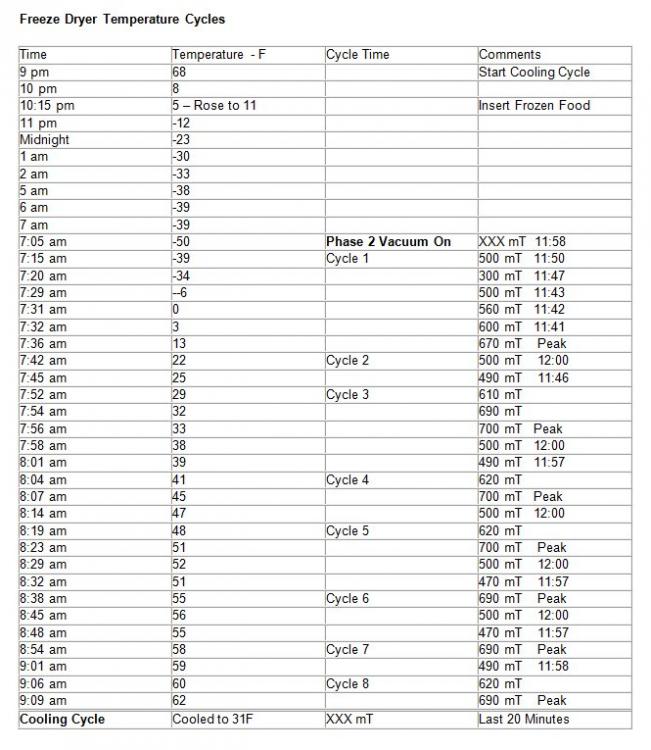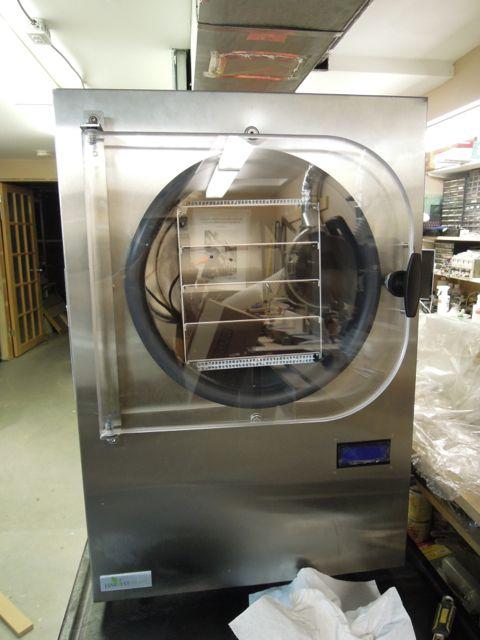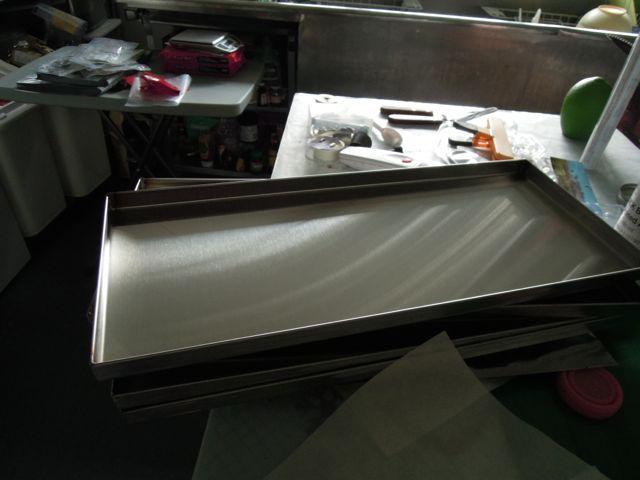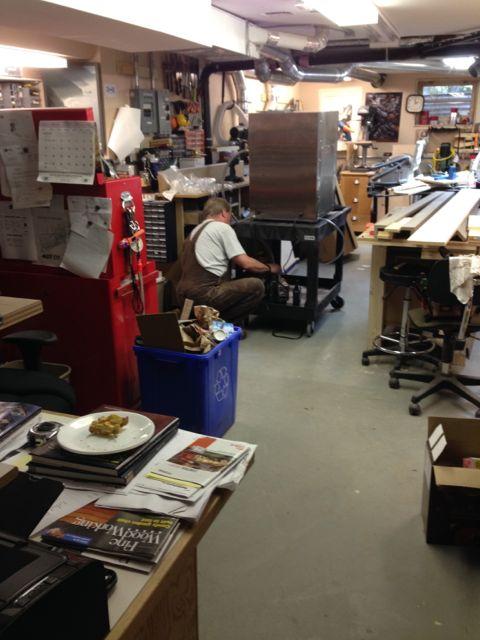Search the Community
Showing results for tags 'Freeze Drying'.
-
Host's note: this topic is continued from Freeze Dryers and Freeze Dried Food (Part 1). Hello everyone, We are new to this discussion having just purchased and rec’d our freeze dryer a week ago. I have read with interest the exploits from all of you over the last 20 pages and simply want to thank all the participants for sharing their knowledge. We have now completed our 7th batch of freeze dried food with great success (thanks in no small part to the knowledge obtained here). It has inspired me to give back as well. I have two thoughts to contribute to this discussion. The first is a warning and the second is an observation. First the warning – Botulism For anyone who has canning experience beyond making jams or jellies, you know the dangers of botulism. We use pressure cookers and proven recipes to insure we kill the bacteria before we can our food. These recipes include not only the ingredients, but the cooking pressure and the minimum time to cook the food. The “USDA Complete Guide to Home Canning” is the bible when it comes to this method of preserving food. A quick google search will turn of quote above will get you to the guide. Why am I bringing this up? Because the bacteria that causes Botulism thrives in an oxygen deprived moist environment. Putting away food that is not completely freeze dried in Mylar bags or canning jars by pulling a vacuum or using O2 packets can potentially put you and your family at serious risk. With the above said, we have successfully vacuum sealed dry staples for years by simply pulling a vacuum. We have also canned meats and stews with pressure cookers successfully, but we have always erred heavily on the side of caution. I urge you to do the same when you freeze dry your food. Err on the side of longer cycles to insure that the food you remove is completely dry (under 5% moisture content – the lower the better). If any of your freeze dried food has a frozen center and you store it in an oxygen free environment, you are putting yourself and your family at risk. Botulism is odorless and tasteless. And you won’t know that you are infected until you are ill. This is serious! From Wikipedia Botulism is a rare and potentially fatal paralytic illness caused by a toxin produced by the bacteria Clostridium botulinum. The disease begins with weakness, trouble seeing, feeling tired, and trouble speaking. This may then be followed by weakness of the arms, chest muscles, and legs. The disease does not usually affect consciousness or cause a fever.[2] Botulism can occur in a few different ways. The bacterial spores that cause it are common in both soil and water. They produce botulinum toxin when exposed to low oxygen levels and certain temperatures. Foodborne botulism happens when food containing the toxin is eaten. Prevention is primarily by proper food preparation. The toxin is destroyed by heating to more than 85 °C (185 °F) for longer than 5 minutes. It is not recommended to give honey to children who are less than one year of age due to the risk with this food. Treatment is with an antitoxin. In those who lose their ability to breathe on their own, mechanical ventilation potentially for months may be required. Death occurs in 5 to 10% of people. In all cases, illness is caused by the botulinum toxin produced by the bacterium C. botulinum in anaerobic conditions, and not by the bacterium itself Improperly preserved food is the most common cause of food-borne botulism. Fish that has been pickled without the salinity or acidity of brine that contains acetic acid and high sodium levels, as well as smoked fish stored at too high a temperature, presents a risk, as does improperly canned food. Foodborne botulism results from contaminated food in which C. botulinum spores have been allowed to germinate in low-oxygen conditions. This typically occurs in home-canned food substances and fermented uncooked dishes.[10] Given that multiple people often consume food from the same source, it is common for more than a single person to be affected simultaneously. Symptoms usually appear 12–36 hours after eating, but can also appear within 2 hours to 10 days. Although the botulinum toxin is destroyed by thorough cooking over the course of a few minutes,[19][20] the spore itself is not killed by the temperatures reached with normal sea-level-pressure boiling, leaving it free to grow and again produce the toxin when conditions are right. 2nd The Observation Being the curious sort that I am I placed an Accurite Thermometer in my Freeze Dryer to see what was going on inside this great little box. I followed the cycles through the Freeze cyle and into the two hours into the Vacuum cycle I had previously moniotored the 3rd phase. I was surprised by what I found and had to go do some reading on freeze drying techniques to begin to understand what was happening. I set the cooling cycle to 10 hours so I could achieve maximum cooling. Post Dry time was set to 12 hours. See my observations in the table below. The temperature probe was placed behind the insulation disc seated on the bottom of the cylinder in front of the trays. I secured the temperature gauge to the door with a magnet. It was within inches of the sending unit inside the chamber. I wanted to know how long it took to reach maximum cooling. The answer is 8 hours. Best time to put in pre-frozen food? The answer is 1 hour. The temperature in the Freeze Dryer will be very close to the temperature of your freezer at that point. I was amazed at how fast the temperature dropped when the vacuum pump first kicked on. The temps literally dropped dramatically by 11F from -39F to - 50F in less than 2 minutes. There was a frost line completely around the bottom of my door gasket from 2 o’clock to 10 o’clock. I was equally amazed to see the internal temperature rise from -50F to +60F in 2 hours. The temps at the time in my garage were 62F. I surmise that the chamber walls stay well below freezing while the food dries out above freezing in a near vacuum. I set my freeze dryer to reach below 10 mT for a few hours before completion in the hopes that the almost complete vacuum helps to sublimate the moisture in the food. There is a great deal of engineering going on that I am not sure I completely understand. I fully expected to see temps well below freezing through all three cycles. This is obviously not the case. All this said, I love the function that the machine brings to me. I think better understanding of the strengths and limitations of the unit will aid each of us in setting our expectations realistically, and insures that we optimize the machine to its fullest. We all want freeze dried food that is nutritious, and safe to eat. Understanding the process will only help us make intelligent decisions. I hope my contributions are worth something to someone. Thanks again for this group leading the way. Kindest Regards, Tony Edited to change table to picture for proper viewing and cleanup text... I'm trying!
-
CALLING ALL FREEZE DRYER OWNERS: Project: Freeze Drying: A Quick reference guide for Tips, Hints and FAQ’s for Freeze Drying. i.e. Collector document. As part of trying to organize all the different questions and topic discussed, I made a proposal to organize the different topics for new and seasoned owners for their results and experiences in using our freeze dryers. We have support from the higher ups for organization, editing and posting this Freeze Drying Reference Guide. Food drying is ONE of many topics that will be addressed in this reference guide. Next: an outline for the Food drying results section. Mr. Mike
-
Hi. Found this forum via a search engine regarding home freeze drying. Thanks for adding me to the community. We are about 6 weeks into exploring this addictive process and try to run it as often as possible with a variety of meats, vegetables and other good stuff (lets not forget ice cream sandwiches). Located in the Little Rock, AR area. Looking forward to sharing experiences.
-
I am looking for some advice on how to work with freeze dried fruit powders. I am using the powders to create purees by rehydrating with water. The end result either comes out very thick & heavy but very flavorful or thinned out & little flavor. I was looking for a way to make the thicker version lighter & airy. I can only use powders for this and the only tool would be to shake once the water is added. Any suggestions? thanks Jason
-
- Modernist Cuisine Forums
- Modernist
-
(and 1 more)
Tagged with:
-
I'm a bit of a food geek - I've got a lab background and often fall back on familiar lab equipment for various projects that I'm playing with. I have an extensive collection of graduated cylinders, beakers, flasks, thermometers, refractometers... Back in 2006 I purchased a used lab vacuum microwave from e-bay - cost me somewhere in the range of a hundred bucks. Never did get it to work the way I had hoped though. I've been watching freeze driers on e-bay for about 10 years - seriously considered a couple of them - but they were rather huge - would have taken up the better part of the garage. They were also 220 V. I have 220 in my chocolate room - but there is a limit to the number of things I can plug in there. Also some had been used to freeze dry dead animals - which I didn't think would provide me with a food safe unit! Back in early August Ninagluck posted about a Sosa product called Airbag - it's pork skin granules that you use as breading. That got me started looking at freeze driers again. I discovered that a company in Utah was making a home unit - 110V - about the size of a small freezer. Well - conveniently Chocolot lives in Utah and it just so happened she was heading to the area the day after I contacted her - so off she went to check this out for me. She was sent home with some samples of things they had dried that she then dipped in chocolate and returned to them. Pictures arrived - contacts were made - and the rest is history. Chocolot has been back there several times - getting the fellows who manufacture the units to freeze dry different products that she wants to play with. Bet it won't be long before she has one too! It arrived on Wednesday - hubby took it down to his workshop and unpacked it. I had to wait until Friday to grab a cart from Uline to put it on - 'cause after hubby saw it he decided the cart I had earmarked for it was not suitable! Today finally he adjusted the door which had gone off a little in transport, hooked up the vacuum pump, pulled out the drain hose from it's hiding spot. There are a couple more things he needs to do with it before he will release it into my care. So with any luck by tomorrow afternoon I can start on my first project. Hubby working on the vacuum pump. The innards. The trays. In the next post I'm going to explain a bit about the theory of freeze drying - but I'm hoping this thread will serve as a bit of a journal of my experiments - and I hope others might jump in if they get bitten as badly as me. I think it would be a good place to talk about commercial freeze dried products as well.
-
Well, I've been trolling eBay for a while now, and finally found one of these beasts in good condition at a reasonable price. Now the fun starts... I'm brainstorming ideas on what to do with it. Gourmet astronaut ice cream? Crispy cheesecake? Some weird variant on beef jerky? What else?
-
I'm extremely interested in freeze drying food. The process involves freezing food and then placing it in a strong vacuum. I know you can do a work-around by freezing slices of things and placing them on a perforated tray in your freezer for about a week. The idea being that the water sublimates without passing into the liquid state.This takes way too long and can only be done practically with very thin slices. The question is: Can something be worked out with a chamber vac? Holding it under pressure for awhile perhaps? Is the vacuum strong enough? I don't have a chamber vac, but I know a few of y'all do - are you interested in trying out an experiment?
-
I found a source- nutrifruit. It seems quite expensive- 24$ for 142g or 5 oz. I was wondering what you use? I thought to use not only in ganache or for rolling truffles in but in the couverture- does anyone use itfor this application? Thanks









